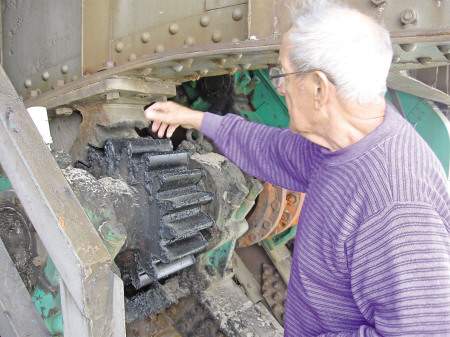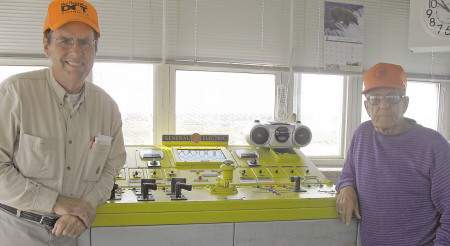By Aimee Lockhardt
Hampton Union, Friday, September 11, 2009
[The following article is courtesy of the Hampton Union and Seacoast Online.]

[Aimee Lockhardt photo]
HAMPTON BEACH — For some traveling home late at night, the drawbridge that connects Hampton and Seabrook can be a nuisance. Yet many don’t know the rich history behind the bridge or even the men who work behind the scenes. Two of these men are Sal Rubera and George “Wick” Elderkin.
How does one get a job as a bridge operator? Rubera and Elderkin’s stories start in much the same way.
Elderkin said he has always had an interest in nautical things and worked on the Sarah Mildred Long and Memorial bridges in Portsmouth before he came over to operate the Neil R. Underwood Memorial Bridge. It was during a Portsmouth Naval Shipyard rally in the 1990s that Elderkin first got involved with operating bridges.
Elderkin remembers that people were asked to park in Portsmouth and while he was walking across the bridge he struck up a conversation with the bridge operator.
“He pretty much hired me on the spot,” Elderkin says.
He has been working at the Underwood Bridge since around 1996, and said his reasoning behind switching bridges is because he just “drifted with the tide down here.”
Rubera, who has been operating the Underwood Bridge for over 11 years, worked as an architect before he became a bridge operator. Living on the Seabrook Beach, Rubera was and still is a frequent biker across the bridge.
As a result, he got to know one of the bridge operators. After he went into an early retirement, Rubera was soon called and asked if he would like to operate the bridge.
“It’s only temporary (half the year),” Rubera explains his decision, “and I needed something to do.”
Or as Elderkin joked, “His charming wife needed to get him out of the house.”
Bridge operators work from the first of April to the end of October, which is the time mandated by the Coast Guard for when the Underwood Bridge should be manned. This requires operators to be at their post three hours before high tide and three hours after. Of course, the work schedule never stays consistent with the tides always changing.
A regular shift can last anywhere from five to nine hours, that is if there are no “call backs.” Call backs are special requests to lift the bridge requested by boats coming back in to dock at times not within the regular hours. These are usually party boats that take patrons out into the ocean on special fireworks cruises.
All special lifts must be scheduled ahead of time in order to make sure an operator is at his post when the vessel comes in. In some cases, call backs can be scheduled for as early as 3 a.m. or as late as 10 p.m.
The added benefit of having Rubera as an operator is that he is just a bike-ride away and can easily get to the bridge in case of an emergency or the need for a special lift.
On this particular day, the schedule calls for operators from 3 a.m. to 6 p.m., but Rubera will not be working all 15 hours, nor will he be working alone. Along side him will be Elderkin.
There are three crews of two people who take turns fronting an operator’s shift. Two operators are there for safety reasons, explains Elderkin. If an emergency should arise there is an extra pair of hands to help sort things out.
Such was the situation five years ago when the bridge failed to go down after it was lifted. For four hours, the bridge was shut down and traffic rerouted while electrical repairs were made.
This was the second time this problem occurred. In 2001 the bridge was shut down for about eight hours because of a broken drive shaft.
The bridge is operated by two large electric motors, which work to crank gears that allow a portion of the bridge to lift up vertically creating a space for large boats to pass through. The motors are held on the third floor of the four-story building that Elderkin describes as being “like a lighthouse.”
“There’s enough stuff in here (that) it’s hard to believe they could fit it all in!” exclaimed Rubera.
A little known fact is that Underwood Bridge did not originally start off as a drawbridge. In 1900, the original bridge, created by Wallace D. Lovell, was entirely made out of wood. Dubbed the Mile-long Bridge, it was believed to be the longest wooden bridge in the world during that time, spanning 4,740 feet.
There were even tracks installed for a trolley that would take passengers back and forth across the Hampton River. As the years went on, the bridge began to crumble, and in 1949 the state constructed a steel bridge in its place.
The bridge is facing another new change this year with the roads being repaved and new re- enforcements being made. The entire process will take four years with only a quarter of the bridge worked on at a time. Construction has currently been halted due to the upcoming seafood festival scheduled for Sept. 11-13, but it is planned to resume after Labor Day.
The Underwood Bridge is named after Lt. Neil R. Underwood, Jr. Underwood grew up in Hampton and was a lifeguard at Hampton Beach before he signed up as a pilot in the Army Air Force.
Underwood was only 26 when he was killed by friendly fire due to a communication error as he was flying over Corsica, France on August 17, 1944.
Elderkin said one “occupational hazard” of his job was dealing with the seagulls that enjoyed perching on top of the bridge’s lights. Elderkin remembers one time waving his hat to shoo off some seagulls when he got a what he called a “defecating protest.” The seagull “pooped on me,” he said.
Up until about a year ago, large steel gates to block off traffic going on the bridge had to be manually swung open. Now all gates are operated from the old, large, yellow, steel box that also operates the drawbridge and is as old as the bridge itself.
“You could drop a bomb on this,” Rubera said tapping the box lightly, “and it’d probably still be ticking. It’s very rugged.”
While the operator’s box may have made the job easier, it can still be a pain. All operations have to be done in sequence.
For instance, if the drawbridge is lifted before the stop lights or gates are put down an “idiot button,” as Elderkin calls it, flashes and it overrides what was done wrong. This means the operator has to start the sequence all over again.
“After awhile it seems like second nature,” Rubera assures.
Elderkin agreed. “It’s like riding a bicycle.”
“Without tires…” Rubera added.
Today’s technology has made some of what Elderkin and Rubera do easier, but it is of little use when battling an operator’s sworn enemy: fog.
Sometimes when the fog rolls in it can be so thick that not only is it hard for the boats to see the bridge and navigational lights, but it also causes problems the operators, who find it hard to locate the boats. In these cases, the operators use lights and horns that let traffic know something is happening with the bridge and to warn them not to cross.
The horn, which sounds similar to an ambulance’s siren, is what Rubera calls his “Cup of tea. If I’m up everybody’s got to be up!”
There’s not much about his job that Elderkin doesn’t love, but what really irks him is when boats require the bridge to be lifted when all they need to do is lower their radio antenna. It makes the bridge work harder than it needs to, he said.
“On an old bridge like this,” he explains, “we need to go easy on her.”
At the height of the summer, the Underwood Bridge will see as many as 15 to 20 lifts a day.
“For an old bridge like this, that’s an awful lot of lifts,” says Elderkin.
The operators listen to two radio channels: 13 and 16. The latter is the channel for international distress and the Coast Guard. Channel 13 is local and the frequency boats use to contact the Underwood Bridge operators.
The operators keep a log that records things such as the time the bridge was lifted, the vessel’s name and type, what degree the bridge was lifted and the temperature – just to name a few.
When they’re not busy operating the bridge, Rubera and Elderkin’s time in the operator’s tower is spent relaxing. For Rubera, he prefers playing a card game called “45” that he said is popular in the Merrimack Valley region. Elderkin enjoys catching up on a good book, but adds that they also chat about community news and occasionally are able to find something on the TV, when they get reception.
Most of all, the two said they enjoy visitors, which is why many times the door to the operator’s tower will be left open.
“You might say we have a rather Spartan existence,” Elderkin laughs. “I think this is a good time to do a plug — cookies and muffins are always appreciated.”

[Aimee Lockhardt photo]

[Aimee Lockhardt photo]